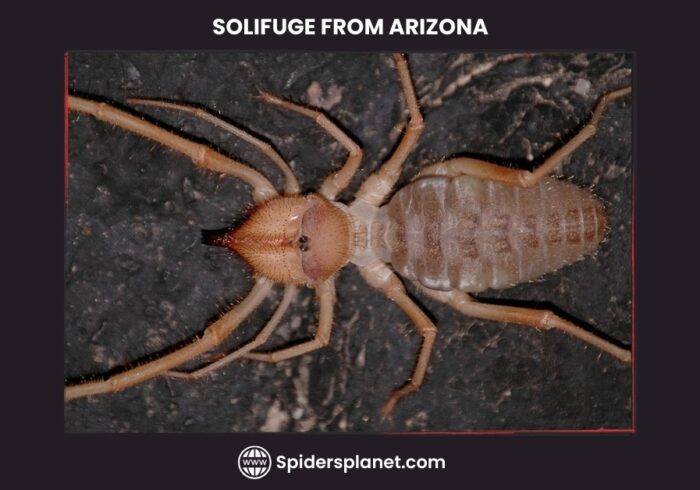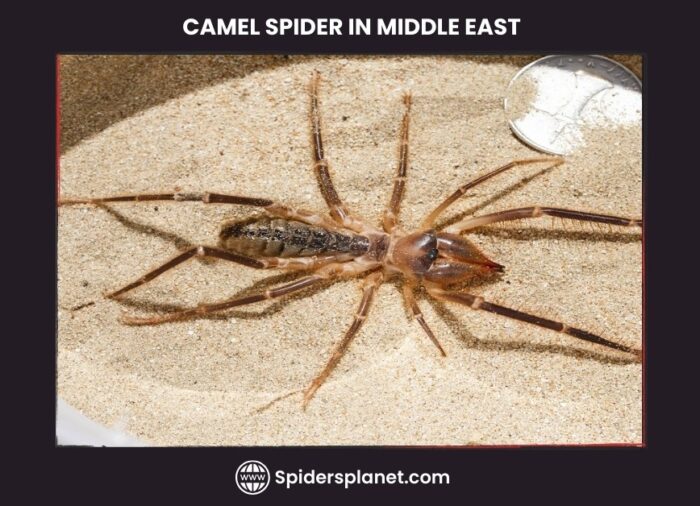Have you ever heard of the speedy superstar of the desert – the Camel spider! This speedy little arachnid is like a tiny racing car, built with legs that are perfect for zipping around the sandy desert chasing after rodents, lizards, and even small birds.
They are like speedy dancers, not like regular spiders that make webs. Also known as the wind scorpion, sun spider, or Solifugae.
It dashes across the sunny desert like a super-fast bullet, making folks in the desert both amazed and a bit scared.
You can find them running around in the deserts of the Middle East, Mexico, and the American Southwest.
Although their bites are not too dangerous, they do hurt quite a bit. So, it is best to appreciate these swift predators from a safe distance.
If you are curious about how fast can a camel spider run, get ready to explore the exciting world of camel spiders, where we will uncover not only their speed but all related information about the camel spider-like, appearance, habitat, habits, diet, lifecycle, and sorting out the real facts from the dusty stories.
So, it is going to be thrilling. Let’s explore the interesting world of camel spider speed and facts. Keep reading…!
Camel Spider Description:
Scientific Name and Family:
Camel spiders, commonly known as wind scorpions or sun spiders, are classified in the Animalia kingdom, Arachnida class, and fall under the order Solifugae, as categorized by Sundevall in 1833.
Despite being called spiders or scorpions, Solifugae is distinct from both the true spiders (order Araneae) and true scorpions (order Scorpiones).
Why are they called Camel Spiders? Myths
The name “camel spider” is somewhat misleading, carrying myths that don’t accurately reflect their relationship with camels.
The nickname likely originates from their shared arid habitat with camels rather than any direct interaction.
Some myths falsely depict them as camel predators, contributing to the name through cultural storytelling.
In reality, camel spiders primarily hunt insects and scorpions, not camels.
While the name persists, it’s more of a descriptive label based on habitat than an accurate representation of their behavior or diet.
Types and Species:
The Solifugae stand as a distinct order, often mistaken for spiders, which belong to a separate order known as the Araneae.
This order of Solifugae encompasses more than 1,200 described species distributed among 146 genera and organized into 16 families.

It highlights the unique characteristics and diversity within this group, emphasizing its separation from the order of true spiders. Some of the species are as under:
- Galeodes arabs
- Galeodes granti
- Eremobates pallipes
- Eremobates docolora
- Eremobates palpisetulosus
- Eremobates mormonus
- Eremobates ctenidiellus
- Giant vinegaroon
- Eremobates scaber
- Eremocosta formidabilis
- Eremocosta gigasella
- Hemerotrecha cornuta
- Zeria sericea
- Hemerotrecha denticulata
- Diplocephalus cristatus
Body / Anatomy:
The camel spider’s anatomy is a marvel of adaptation in arachnids. Its front section, the prosoma, shields the head and legs with a robust carapace composed of three plates.

The prominent chelicerae function as formidable pincers, capable of producing stridulating sounds. Pedipalps, often confused with legs, serve as sensory appendages aiding in various tasks.
True legs, four hind pairs, enable locomotion, while the opisthosoma houses internal organs and reproductive systems.
Notable features include spiracles for breathing, a mysterious flagellum in some species, and chemoreceptors for olfactory perception.
With eight eyes and potent, fang-less chelicerae, the camel spider’s anatomy showcases its remarkable survival strategies in arid landscapes.
Camel Spiders Appearance:
Size:
Camel spiders, or Solifugae, display diverse sizes and colors that help them blend into arid environments.
Most species have a body length of around 5 cm (2 inches), while their leg span can vary, reaching up to 12-15 cm (5-6 inches) in some cases.
The largest, the giant Solifuge (Rhax nicolaii), boasts a body length of 7 cm (3 inches) and a leg span exceeding 12 cm (5 inches).
However, encounters with much smaller individuals are more common.
Colour:
Camel spiders typically exhibit earthy tones ranging from beige to brown, including variations like reddish, orange, and sandy hues.
This color palette serves as effective camouflage in desert environments. Certain species may feature darker patterns or spots on their bodies, and their chelicerae (jaws) can be notably darker than the rest of their body.
Additionally, young spiderlings tend to appear translucent or light-coloured in comparison to the adults.
How Fast Can a Camel Spider Run?
Surprisingly, fast runners are quick when moving on land, especially when compared to other animals without backbones (invertebrates).
Their estimated top speed is around 16 kilometers per hour or 10 miles per hour. To give a comparison, this is nearly half the speed of the fastest human sprinter.
So, in the context of invertebrates, camel spiders are considered quite fast, showcasing their ability to move swiftly across land surfaces.
The speed of camel spiders is influenced by several factors. Different species within the Solifugae order exhibit variations in leg lengths and body structures, impacting their running capabilities.
The type of terrain plays a significant role, with running on sand or loose gravel presenting more challenges compared to flat, solid surfaces.
Temperature also plays a role, and like many desert creatures, camel spiders experience a decrease in activity level and speed in extreme heat.
Moreover, their speed is not geared for long-distance running; instead, they rely on short bursts of rapid movement for specific tasks such as hunting prey or evading predators.
This sprinting behavior aligns with their efficient use of speed in brief, intense bursts rather than sustained endurance over extended distances.
Some fastest spiders with their speeds are as under:
| Spider | Speed |
|---|---|
| Triangle Weaver Spider | 1692 Mph |
| Slingshot Spider | 540 Mph |
| Camel Spider | 10 Mph |
| Moroccan Flic-Flac Spider | 3.60 Mph |
| Hobo Spider | 2.23 Mph |
| Huntsman Spider | 2.23 Mph |
| Giant House Spider | 1.15 Mph |
Behaviour:
Camel spider can run fast and active primarily at night; these predators hunt insects, scorpions, and lizards using powerful chelicerae.
Their opportunistic feeding includes scavenging carrion and consuming plant matter if necessary.
Solitary by nature, camel spiders dig burrows for shelter and guard their eggs until hatching.
When threatened, they display a defensive posture, raising their front legs and chelicerae, and may use vibrations or sounds.
Contrary to myths, they do not chase humans or spit venom, delivering a powerful but non-venomous pinch.
Their mating rituals involve males using pedipalps, and they communicate through scent trails, showcasing adaptability to survive in arid environments by absorbing moisture through their skin and mouthparts.
Where Do Camel Spiders Live?
Camel spiders are habitat specialists, excelling in arid environments across various regions.
They are commonly found in deserts worldwide, including the Middle East, the southwestern United States, and Mexico, where the dry heat and sandy landscapes suit their preferences.

Additionally, semi deserts and scrublands with some vegetation and rocky terrain provide suitable habitats, such as Mediterranean scrublands or rocky steppes.
While they favor deserts, these arachnids exhibit surprising diversity and are distributed on most continents, excluding Antarctica and Australia.
Their adaptability is further evident in microhabitat variations within these broad regions, with preferences for sand dunes, rocky outcrops, or sandy plains, depending on the species.
Camel spiders have evolved to thrive in arid conditions by adopting a nocturnal routine, emerging at night to conserve moisture and avoid predators.
They can take in moisture through their skin and mouthparts, making use of dew or limited water sources.
Despite their resilience, these creatures face threats to their habitat, including desertification, climate change, and human development.
It is vital to undertake conservation initiatives to protect camel spiders and the ecosystems they call home.
What They Like to Eat?
These carnivorous creatures have quite a diverse diet. Camel spiders have a diverse diet, feasting on a variety of prey, such as lizards, small birds, gerbils, beetles, snakes, and termites.
Their carnivorous nature allows them to consume different types of animals depending on what is available in their surroundings. Interestingly, as camel spider run fast so it can have prey larger than themselves.
Similar to many other animals, their food choices depend on what’s abundant in their surroundings.
To locate and catch their prey, camel spiders use their pedipalps and jaws. The digestion process is unpleasant; they utilize their digestive juices to turn their captured prey into a pulpy liquid for consumption.
In times when food is scarce in deserts and scrublands, camel spiders have a unique strategy: they store fat in their bodies to sustain them during periods when they can’t find prey.
Lifecycle, Reproduction, Babies:
These arachnids, being oviparous, lay between 50 and 200 eggs in protected burrows or crevices.
Mating strategies vary, involving scent trails, courtship dances, and even the male offering food to the female.
Unique to camel spiders, fertilization occurs when males deposit a spermatophore on the ground and use their powerful jaws to transfer it to the female’s genital opening.
After an incubation period of around 11 days, tiny nymphs hatch, resembling miniature adults but without reproductive organs.
Nymphs undergo multiple molts, shedding exoskeletons as they grow, with the final molt marking their transition to sexually mature adults.
Solitary by nature, camel spiders exhibit interesting behaviors such as cannibalistic tendencies among nymphs and, in some species, brief parental care where females guard their young and provide pre-digested food.
Lifespan:
Compared to some arachnids like tarantulas, camel spiders live a relatively short life. They generally live for several months to a year, with some species potentially stretching to two years in ideal conditions.
Predators:
Camel spiders, despite their imposing appearance, face diverse threats in their desert habitats.
Predators include birds like owls and hawks, larger scorpions, ground-dwelling spiders, and mammals such as lizards, snakes, and foxes. Cannibalism is also observed in some species, especially during resource scarcity.
Are Camel Spiders Poisonous?
Contrary to common misconceptions, camel spiders are not poisonous. Despite their intimidating appearance and swift movements, they lack venom glands and fangs.
Consequently, they are unable to inject any poisonous substance into their prey or potential threats. Their strong jaws, while capable of delivering a painful bite, do not carry venom.
Though these bites can lead to swelling, redness, and potential infection if not properly cleaned, they are seldom life-threatening, particularly for healthy adults.
Also Read: How Fast Can A Tarantula Run?
Summarizing with Quick Facts About Camel Spiders:
- Camel spiders, despite their eight legs, belong to a distinct order called Solifugae.
- They are primarily insectivores and scavengers, preying on smaller creatures.
- Bites from camel spiders can be painful due to powerful jaws (chelicerae), but they lack venom glands.
- Camel spider can run up to 10 mph over short distances, though jumping is not a notable ability.
- Despite their intimidating appearance, they are generally skittish and prefer fleeing to fighting.
- Fossil evidence suggests that camel spiders roamed the Earth over 300 million years ago.
- Active primarily at night, camel spiders use their powerful chelicerae to crush prey.
- As camel spider can run fast, it can detect prey from several meters away using scent receptors.
- Thriving in hot, dry deserts like the Middle East and North Africa, camel spiders have impressive regenerative abilities, capable of regrowing lost limbs.
- Camel spiders have chemoreceptors on their pedipalps (second pair of appendages) for tasting and smelling.
- They exhibit fascinating “running turns” with their long legs, showcasing agile maneuvers.
- Camel spiders play a vital role in desert ecosystems by controlling insect populations.
FAQs:
How fast does a camel spider run?
Camel spiders are known for their relatively fast movement, reaching speeds of up to 16 kilometers per hour (10 mph).
While they are capable of moving quickly, the exact speed can depend on factors such as species, size, and environmental conditions.
Do camel spiders eat camels?
No, camel spiders do not eat camels. Their name is simply a misconception.
They are primarily opportunistic predators that feed on smaller insects, lizards, rodents, and other invertebrates.
How to get rid of camel spiders?
If you find any camel spiders in your home, avoid direct contact with the potential bites, which can be painful.
Take steps to remove them by sealing possible entry points, using sticky traps, applying pesticides in their hiding areas (following instructions carefully), and seeking professional pest control assistance for severe infestations.
Is camel spider dangerous?
Despite their frightening appearance, camel spiders pose little danger to humans. While their bites can be painful, they lack venom, and medical attention is rarely necessary.
Nevertheless, it is advisable to monitor for potential infections and consult a doctor if any concerns arise, as with any insect bite.
Can camel spiders jump?
Camel spiders, unlike typical spiders, are not known for their jumping abilities. Their hunting strategy mainly revolves around their impressive speed and powerful jaws.
While they lack the specialized jumping adaptations of some spiders, they can still climb walls and execute small jumps to reach prey or escape potential threats.
Do camel spiders chase you?
Camel spiders, also known as “wind scorpions,” are not actively aggressive and won’t chase humans in a predatory manner.
If they encounter something unexpected or feel threatened, they may exhibit a quick and defensive response, such as running in a certain direction.
Are there camel spiders in Oregon?
No, camel spiders are not commonly found in Oregon. Their preferred habitat is hot, dry deserts, and Oregon’s temperate climate generally does not suit their needs.
How long can camel spiders run?
Camel spider can run fast for a few seconds. It can also move at slower speeds for a longer time, but if it run really fast for too long, they get tired quickly.




Leave a Reply